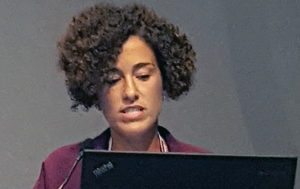
Six-month results from a prospective, randomised, non-inferiority study presented at the Cardiovascular and Interventional Radiological Society of Europe (CIRSE; 16–20 September, Copenhagen, Denmark) reveal that prostatic artery embolization is safe and effective in the treatment of benign prostatic hyperplasia (BPH) and that it results in symptomatic improvement for patients based on achieving a decrease in prostate volume.
Ana Sáez de Ocáriz García, Complejo Hospitalario de Navarra, Pamplona, Spain, who reported the results, said: “This clinical trial shows that prostatic artery embolization is a real alternative that is not inferior to transurethral resection. Further, the results show that there are no severe complications related to prostatic artery embolization. We would like to emphasise the importance of teamwork between urology and interventional radiology in furthering this treatment.”
BPH can result in lower urinary tract symptoms (LUTS) which are usually treated with medication at first instance. However, medical treatment often fails in the medium to long term. At this point, the “gold standard” treatment offered to patients is transurethral resection of the prostate (TURP), but there are many alternatives that are being explored such as microwave treatment, laser ablation, and high-intensity focused ultrasound. Supraselective transarterial embolization of the prostate is one such treatment alternative and interventionists hope that it will have the same effectiveness, but with fewer side-effects.
The randomised trial set out to compare clinical and urodynamic results of prostatic artery embolization and TURP in the treatment of LUTS in patients with BPH. The triallists also set out to evaluate early complications related to sexual function and compare the gain in quality of life between the two treatments.
“In our study, we enrolled 80 patients. Twenty one were excluded and then 60 patients were randomised in a 1:1 ratio. We assigned 30 to the embolization group and 30 to the TURP group (however, one patient declined the surgical procedure). There was no substitution mechanism and the treatment allocation was not masked. We collected data on maximum urinary flow rate (Qmax), international prostate symptom score (IPSS), quality of life (QoL), international index erectile function (IIEF), prostate specific antigen, prostatic volume, and post void residual volume in the follow-up visits scheduled for one, three, six and 12-months after treatment. Here, we present the six-month results,” Sáez de Ocáriz García said.
Patients had to be older than 60 years of age, diagnosed with BPH and have moderate or severe obstructive LUTS that was refractory to six months of medical therapy in order to be eligible. They also needed to have a Qmax of less than 10mL/s, and to be able to provide written informed consent. Baseline characteristics between the two groups were comparable.
Exclusion criteria
Patients were excluded if they had severe atherosclerosis and tortuousness of the iliac arteries; unidentifiable prostatic arteries by CT angiography; allergy to iodinated contrast; uretheral stenosis; neurogenic bladder; malignant tumour; glomerular filtration rate of less than 30mL/minute; and any other important and uncontrolled disease that interferes with participating in a trial.
Endpoints
The improvement in maximum urinary flow rate (Qmax) was the main effectiveness endpoint. Secondary endpoints included improvement in IPSS score. Reduction in prostatic volume, no worsening or improvement of erectile function; reduction of PSA and post-void residual volume; and patient satisfaction with the intervention performed.
“One of the most important things is CT angiography that helps to select patients and obtain the imaging needed to perform the procedure. While the origin of the prostatic arteries is very variable, the most important arteries are the internal pudendal, gluteal pudendal, obdurator artery and vesical-prostatic artery,” she noted.
Results
The investigators achieved technical success in 100% of patients with both techniques. At 24-hours, patient satisfaction with embolization was nearly 84%; whereas it was 77% with TURP. Those who underwent embolization reported a mean pain score of 0.5, compared to those who underwent TURP (mean VAS =2.9). On average, embolization was a longer procedure than TURP. On average, those who underwent embolization stayed in hospital for a day, when compared to nearly two days for those who underwent TURP. There were no complications with either procedure.
At six months, there was significant improvement in the Qmax of both groups with the gains being very similar. There was also improvement in the IPSS score in both groups, with TURP appearing to confer a greater benefit. “Most of the quality of life improvement was seen in the first three months after the procedure with some subsequent stability. While post-void residual volume reduction was similar in both groups, the reduction of prostate volume was greater with TURP than embolization,” Sáez de Ocáriz García explained.
Minor complications after embolization included haematuria (two patients); haematospermia (two patients); intermittent claudication (one patient) and radiodermatitis (one patient). There was also one major complication—a rectal ischaemic plaque.
Minor complications after TURP included urinary incontinence (one patient); stenosis of the urethral meatus (one patient); testicular pain (one patient) and urinary urgency (one patient). There was also one major complication of urethral stenosis in one patient.
“The results after six months of embolization were a decrease of 25 points in IPSS, an increase of three points on IIEF, and a decrease of 37.2% in prostate volume. All patients with acute urinary retention could remove the bladder catheter, three weeks after,” the authors reported.












